Let’s play english
人教版PEP五年级英语上册Unit2教案
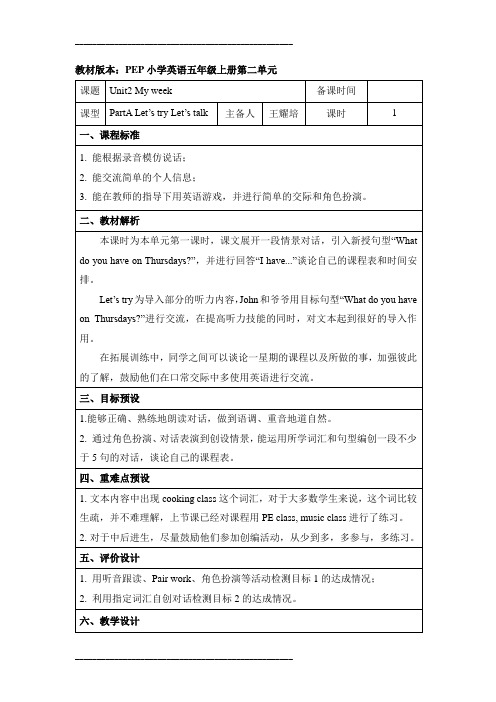
五、评价设计
1.用听音跟读、Pair work、角色扮演等活动检测目标1的达成情况;
2.利用指定词汇自创对话检测目标2的达成情况。
六、教学设计
第1课时
教学环节
教学预设
一、热身/复习(Warm-up/Revision)
1. Sing a song.
学生问答:“We have ... on Mondays.”
Pair work同桌练习,一问一答。
小组PK展示。
2.Let’s play.制作自己的课程表
每组用一张白纸,画好格子,制作课程表。
老师事先做好一份,然后和学生展开对话。
T: You have English, Chinese, art and music on that day.
八、课后巩固作业
MATCH
1. Thsday A.星期一
2. WednesdB.星期二
3. Fday C.星期三
4. Tsday D.星期四
5. Mday E.星期五
答案:1. ur D 2. ay C 3. ri E 4. ue B 5. on A
九、课后反思
课题
Unit2 My week
备课时间
Name
Wednesday
Thursday
John
art
maths,
English, music
Mike
Chen Jie
2. Show time: each group choose some kids to say about the list.
With the sentence:
has and on .
迪士尼神奇英语 第十课 Let′s play 玩
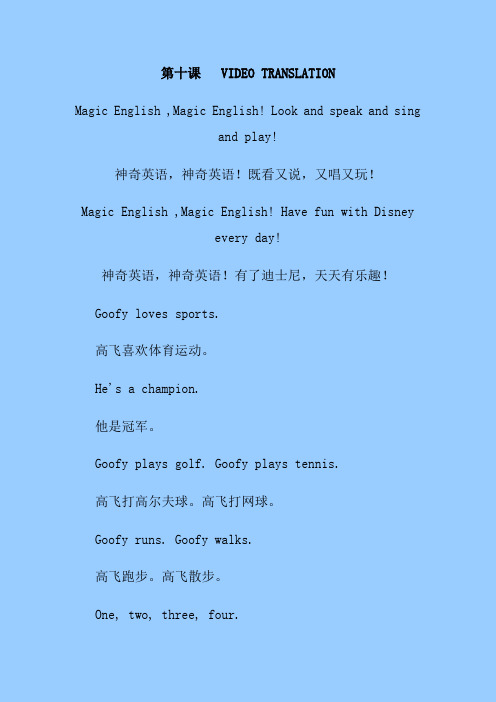
第十课 VIDEO TRANSLATIONMagic English ,Magic English! Look and speak and singand play!神奇英语,神奇英语!既看又说,又唱又玩!Magic English ,Magic English! Have fun with Disneyevery day!神奇英语,神奇英语!有了迪士尼,天天有乐趣!Goofy loves sports.高飞喜欢体育运动。
He's a champion.他是冠军。
Goofy plays golf. Goofy plays tennis.高飞打高尔夫球。
高飞打网球。
Goofy runs. Goofy walks.高飞跑步。
高飞散步。
One, two, three, four.一、二、三、四。
Goofy dances. Goofy jumps.高飞跳舞。
高飞跳高。
Goofy is a champion.高飞是冠军。
Goofy's running.高飞正在跑。
He's running slowly. but he can run very fast. 他慢慢地跑,但他可以跑得很快。
Goofy's walking. He can walk fast.高飞正走,他能走得很快。
Goofy's jumping.高飞跳高。
He can jump very high.他可以跳得很高。
Goofy is running slowly.高飞在慢慢地跑。
Goofy can run fast. Goofy can walk fast. Goofy can jump high.高飞可以跑得很快。
高飞可以走得很快。
高飞可以跳得很高。
Goofy is a champion.高飞是冠军。
Play. High. Fast. Slow.玩。
高。
快。
慢。
Do you want to play?Yes, we want to play.你们想玩吗?是的,我们想玩。
PEP三上英语Unit1第一课时 Part A Let’s talk Let’s play优课教案
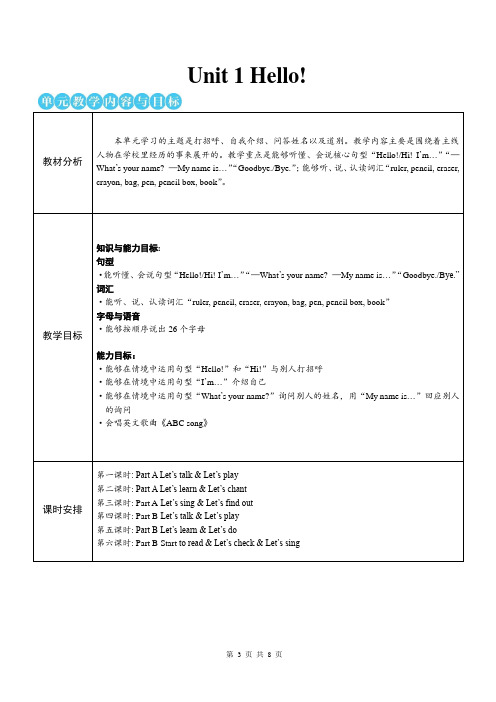
Unit 1 Hello!教材分析本单元学习的主题是打招呼、自我介绍、问答姓名以及道别。
教学内容主要是围绕着主线人物在学校里经历的事来展开的。
教学重点是能够听懂、会说核心句型“Hello!/Hi! I’m…”“—What’s your name? —My name is…”“Goodbye./Bye.”;能够听、说、认读词汇“ruler, pencil, eraser, crayon, bag, pen, pencil box, book”。
教学目标知识与能力目标:句型·能听懂、会说句型“Hello!/Hi! I’m…”“—What’s your name? —My name is…”“Goodbye./B ye.”词汇·能听、说、认读词汇“ruler, pencil, eraser, crayon, bag, pen, pencil box, book”字母与语音·能够按顺序说出26个字母能力目标:·能够在情境中运用句型“Hello!”和“Hi!”与别人打招呼·能够在情境中运用句型“I’m…”介绍自己·能够在情境中运用句型“What’s your name?”询问别人的姓名,用“My name is…”回应别人的询问·会唱英文歌曲《ABC song》课时安排第一课时: Part A Let’s talk & Let’s play第二课时: Part A Let’s learn & Let’s chant第三课时: Part A Let’s sing & Let’s find out第四课时: Part B Let’s talk & Let’s play第五课时: Part B Let’s learn & Let’s do第六课时: Part B Start to read & Let’s check & Let’s sing第 3 页共8 页第 4 页 共 8 页The first period (第一课时) Part A Let’s talk & Let’s play▶教学内容与目标课时教学内容课时教学目标Let’s talk·能够通过观察、谈论Let ’s talk 板块的图片,并在PPT 和教师的帮助下理解对话大意 ·能够通过听录音,学会用正确的语音、语调朗读对话,并能在小组中进行角色扮演 ·能够听懂、会说核心句型“Hello!/Hi! I ’m …”·能够在情景中运用“Hello!/Hi!”与别人打招呼并运用句型“I ’m …”介绍自己Let’s play·能够在模拟或真实的情景中运用“Hello!/Hi!”与别人打招呼并运用句型“I ’m …”介绍自己▶教学重点1. 能够理解和掌握本课时的重点句型。
牛津英语7A Unit 2Let's play sports 重点用法梳理
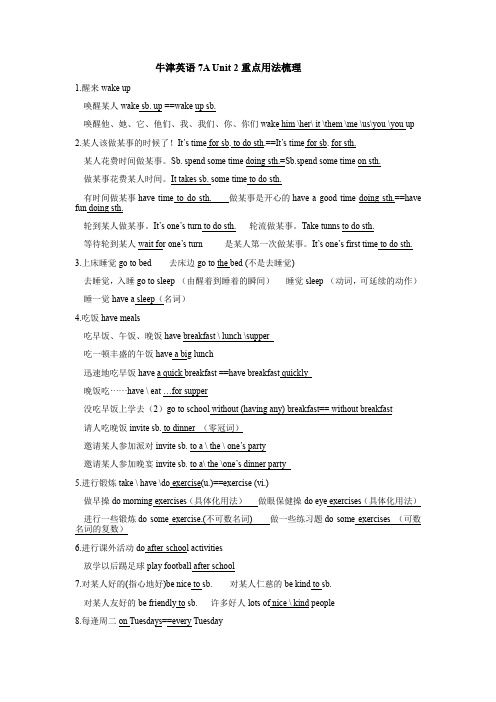
牛津英语7A Unit 2重点用法梳理1.醒来wake up唤醒某人wake sb. up ==wake up sb.唤醒他、她、它、他们、我、我们、你、你们wake him \her\ it \them \me \us\you \you up 2.某人该做某事的时候了!It’s time for sb. to do sth.==It’s time for sb. for sth.某人花费时间做某事。
Sb. spend some time doing sth.=Sb.spend some time on sth.做某事花费某人时间。
It takes sb. some time to do sth.有时间做某事have time to do sth. 做某事是开心的have a good time doing sth.==have fun doing sth.轮到某人做某事。
It’s one’s turn to do sth. 轮流做某事。
Take tunns to do sth.等待轮到某人wait fo r one’s turn 是某人第一次做某事。
It’s one’s first time to do sth.3.上床睡觉go to bed 去床边go to the bed (不是去睡觉)去睡觉,入睡go to sleep (由醒着到睡着的瞬间)睡觉sleep (动词,可延续的动作)睡一觉have a sleep(名词)4.吃饭have meals吃早饭、午饭、晚饭have breakfast \ lunch \supper吃一顿丰盛的午饭have a big lunch迅速地吃早饭have a quick breakfast ==have breakfast quickly晚饭吃······have \ eat …for supper没吃早饭上学去(2)go to school without (having any) breakfast== without breakfast请人吃晚饭invite sb. to dinner (零冠词)邀请某人参加派对invite sb. to a \ the \ one’s party邀请某人参加晚宴invite sb. to a\ the \one’s dinner party5.进行锻炼take \ have \do exercise(u.)==exercise (vi.)做早操do morning exercises(具体化用法)做眼保健操do eye exercises(具体化用法)进行一些锻炼do some exercise.(不可数名词) 做一些练习题do some exercises (可数名词的复数)6.进行课外活动do after-school activities放学以后踢足球play football after school7.对某人好的(指心地好)be nice to sb. 对某人仁慈的be kind to sb.对某人友好的be friendly to sb. 许多好人lots of nice \ kind people8.每逢周二on Tuesdays==every Tuesday在周二on Tuesday 在周二上午、下午、晚上on Tuesday morning \ afternoon \ evening 每周二的上午on Tuesday mornings ==every Tuesday morning9.她是一个很棒的游泳者。
牛津译林版英语7A Unit2Let's play sports 单元知识解析
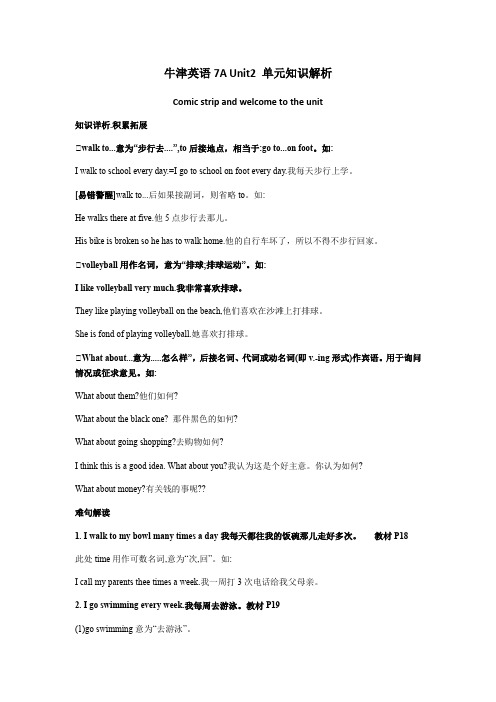
牛津英语7A Unit2 单元知识解析Comic strip and welcome to the unit知识详析.积累拓展➊walk to...意为“步行去....”,to后接地点,相当于:go to...on foot。
如:I walk to school every day.=I go to school on foot every day.我每天步行上学。
[易错警醒]walk to...后如果接副词,则省略to。
如:He walks there at five.他5点步行去那儿。
His bike is broken so he has to walk home.他的自行车坏了,所以不得不步行回家。
❷volleyball用作名词,意为“排球;排球运动”。
如:I like volleyball very much.我非常喜欢排球。
They like playing volleyball on the beach,他们喜欢在沙滩上打排球。
She is fond of playing volleyball.她喜欢打排球。
❸What about...意为.....怎么样”,后接名词、代词或动名词(即v.-ing形式)作宾语。
用于询问情况或征求意见。
如:What about them?他们如何?What about the black one? 那件黑色的如何?What about going shopping?去购物如何?I think this is a good idea. What about you?我认为这是个好主意。
你认为如何?What about money?有关钱的事呢??难句解读1. I walk to my bowl many times a day我每天都往我的饭碗那儿走好多次。
教材P18此处time用作可数名词,意为“次,回”。
如:I call my parents thee times a week.我一周打3次电话给我父母亲。
牛津译林版七年级英语上册Unit2Let’s play sports! 知识点归纳
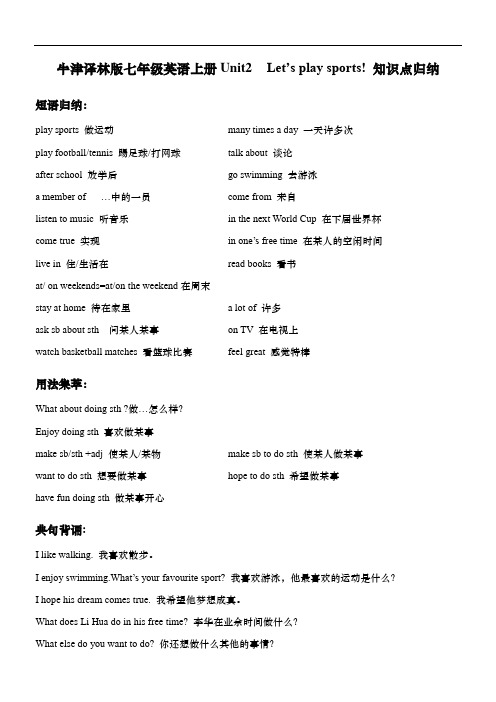
牛津译林版七年级英语上册Unit2 Let’s play sports!知识点归纳短语归纳:play sports 做运动many times a day 一天许多次play football/tennis 踢足球/打网球talk about 谈论after school 放学后go swimming 去游泳a member of …中的一员come from 来自listen to music 听音乐in the next World Cup 在下届世界杯come true 实现in one’s free time 在某人的空闲时间live in 住/生活在read books 看书at/ on weekends=at/on the weekend在周末stay at home 待在家里 a lot of 许多ask sb about sth 问某人某事on TV 在电视上watch basketball matches 看篮球比赛feel great 感觉特棒用法集萃:What about doing sth ?做…怎么样?Enjoy doing sth 喜欢做某事make sb/sth +adj 使某人/某物make sb to do sth 使某人做某事want to do sth 想要做某事hope to do sth 希望做某事have fun doing sth 做某事开心典句背诵:I like walking. 我喜欢散步。
I enjoy swimming.What’s your favourite sport? 我喜欢游泳,他最喜欢的运动是什么?I hope his dream comes true. 我希望他梦想成真。
What does Li Hua do in his free time? 李华在业余时间做什么?What else do you want to do? 你还想做什么其他的事情?Reading is fun. 读书是有趣的事情。
七年级英语上册Unit 2 Let's play sports 第2课时 reading同步练习题
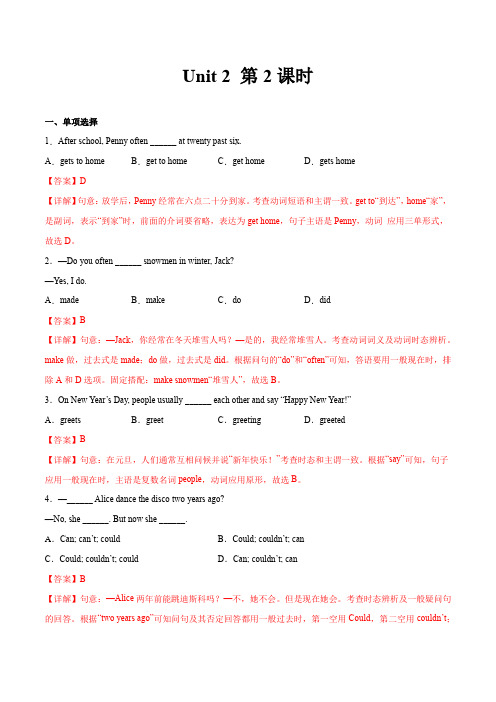
Unit 2 第2课时一、单项选择1.After school, Penny often ______ at twenty past six.A.gets to home B.get to home C.get home D.gets home【答案】D【详解】句意:放学后,Penny经常在六点二十分到家。
考查动词短语和主谓一致。
get to“到达”,home“家”,是副词,表示“到家”时,前面的介词要省略,表达为get home,句子主语是Penny,动词应用三单形式,故选D。
2.—Do you often ______ snowmen in winter, Jack?—Yes, I do.A.made B.make C.do D.did【答案】B【详解】句意:—Jack,你经常在冬天堆雪人吗?—是的,我经常堆雪人。
考查动词词义及动词时态辨析。
make做,过去式是made;do做,过去式是did。
根据问句的“do”和“often”可知,答语要用一般现在时,排除A和D选项。
固定搭配:make snowmen“堆雪人”,故选B。
3.On New Year’s Day, people usually ______ each other and say “Happy New Year!”A.greets B.greet C.greeting D.greeted【答案】B【详解】句意:在元旦,人们通常互相问候并说“新年快乐!”考查时态和主谓一致。
根据“say”可知,句子应用一般现在时,主语是复数名词people,动词应用原形,故选B。
4.—______ Alice dance the disco two years ago?—No, she ______. But now she ______.A.Can; can’t; could B.Could; couldn’t; canC.Could; couldn’t; could D.Can; couldn’t; can【答案】B【详解】句意:—Alice两年前能跳迪斯科吗?—不,她不会。
七年级英语上册 Unit 2 Let's play sports知识点梳理(下)(新版)牛津版

7AUnit 2知识点梳理(下)复习导入重点单词散步,步行 walking 的确,确实 really网球 tennis 排球 volleyball享受…的乐趣,欣赏,喜爱 enjoy 成员 member梦想,梦 dream 希望 hope周末 weekend 队,组 team比赛,竞赛 match 偶像,英雄 hero重点短语play sports 做运动 of course 当然in one’s free time 在某人空闲的时间 go swimming 去游泳listen to music 听音乐 come true 变为现实,成为事实stay at home 待在家里 at/on weekends 在周末a lot of 许多,大量 talk about/of 谈论知识点梳理一.词汇&短语:WORDS&PHRASES1.He/She/It likes sports. 他/她/它喜欢运动。
含有行为动词的一般现在时,当句子的主语是第三人称单数时,谓语动词也用第三人称单数形式,其他情况谓语动词用动词原形。
我来自中国,她来自美国。
I come from China and she comes from America.她对孩子很有耐心,所以她能成为一位好老师。
2. He/She/It does not like sports.他/她/它不喜欢运动。
含有行为动词的一般现在时的否定句型:主语+don’t/doesn’t+ 动词原形+其他。
我根本不喜欢足球。
I don’t like soccer at all.他不生活在中国。
He doesn’t live in China.3. Do I/you/we/ they like sports?我/你(们)/我们/他们喜欢运动。
此句是含有行为动词的一般现在时的一般疑问句形式,其构成可归纳为:Do/Does+主语+动词原形+其他?当主语为第三人称单数时用does。
小学四年级英语上册重点单词和句子(人教精通版)
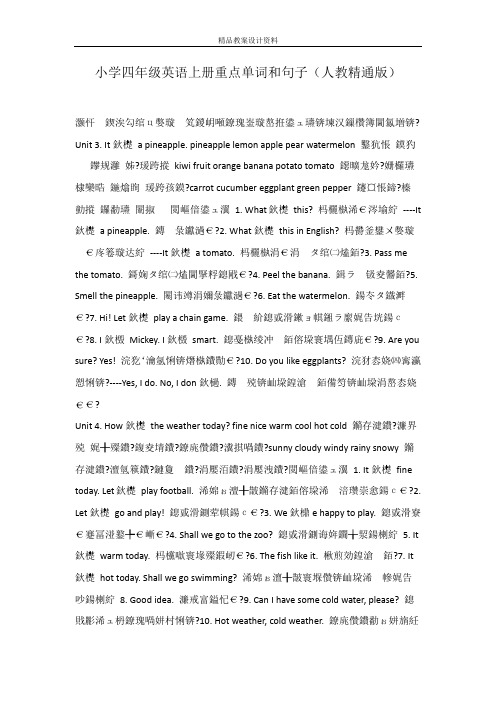
小学四年级英语上册重点单词和句子(人教精通版)ц? Unit 3. It鈥檚a pineapple. pineapple lemon apple pear watermelon 鑿犺悵鏌犳鑻规灉姊?瑗跨摐kiwi fruit orange banana potato tomato 鐚曠尨妗?姗欏瓙棣欒晧鍦熻眴瑗跨孩鏌?carrot cucumber eggplant green pepper 鑳¤悵鍗?榛勭摐鑼勫瓙閲嶇偣鍙ュ瀷 1. What鈥檚this? 杩欐槸浠€涔堬紵----It 鈥檚a pineapple. ?2. What鈥檚this in English? 杩欎釜鐢ㄨ嫳璇----It鈥檚a tomato. ?3. Pass me the tomato. 鎶婅タ绾㈡熆閫掔粰鎴戙€?4. Peel the banana. ?5. Smell the pineapple. 闂讳竴涓嬭彔钀濄€?6. Eat the watermelon. 鍚冭タ鐡溿€?7. Hi! Let鈥檚play a chain game. с€?8. I鈥檓Mickey. I鈥檓smart. ?9. Are you sure? Yes! 浣犵‘瀹氬悧锛熸槸鐨勩€?10. Do you like eggplants? 浣犲枩娆㈣寗瀛愬悧锛?----Yes, I do. No, I don鈥檛.?Unit 4. How鈥檚the weather today? fine nice warm cool hot cold 鏅存湕鐨?濂界殑娓╂殩鐨?鍑夌埥鐨?鐐庣儹鐨?瀵掑喎鐨?sunny cloudy windy rainy snowy 鏅存湕鐨?澶氫簯鐨??涓嬮洦鐨?涓嬮洩鐨?閲嶇偣鍙ュ瀷 1. It鈥檚fine today. Let鈥檚play football. с€?2. Let鈥檚go and play! 鎴戜滑鍘荤帺鍚с€?3. We鈥檙e happy to play. 鎴戜滑寮€蹇冨湴鐜╄€嶃€?4. Shall we go to the zoo? 鎴戜滑鍘诲姩鐗╁洯鍚楋紵 5. It 鈥檚warm today. 杩欓噷寰堟殩鍜屻€?6. The fish like it. ?7. It鈥檚hot today. Shall we go swimming?吵鍚楋紵8. Good idea. 濂戒富鎰忋€?9. Can I have some cold water, please? 鎴戝彲浠ュ枬鐐瑰喎姘村悧锛?10. Hot weather, cold weather. 鐐庣儹鐨勫ぉ姘旓紝瀵掑喎鐨勫ぉ姘斻€?11. Which do you like? 12. How鈥檚the weather today? 浠婂ぉ澶╂皵鎬庝箞鏍枫€?13. Let鈥檚go shopping. 鎴戜滑鍘昏喘鐗╁惂銆?14. Put on your shirt. ?15. It鈥檚so hot today. ?Unit 5. I like those shoes. cap hat T-shirt dress blouse (鏃犺竟)甯藉瓙(鏈夎竟)甯藉瓙T鎭よ~濂宠‖琛?jacket raincoat sweater skirt shirt 澶瑰厠锛涚煭涓婅。
最新pep人教版小学四年级英语上册Unit 2 My schoolbag--B. Let’s talk. Let’s play(第4课时)教案
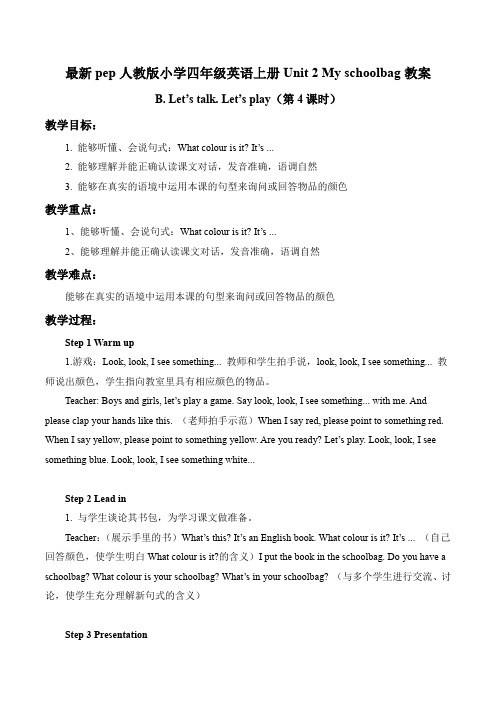
最新pep人教版小学四年级英语上册Unit 2 My schoolbag教案B. Let’s talk. Let’s play(第4课时)教学目标:1. 能够听懂、会说句式:What colour is it? It’s ...2. 能够理解并能正确认读课文对话,发音准确,语调自然3. 能够在真实的语境中运用本课的句型来询问或回答物品的颜色教学重点:1、能够听懂、会说句式:What colour is it? It’s ...2、能够理解并能正确认读课文对话,发音准确,语调自然教学难点:能够在真实的语境中运用本课的句型来询问或回答物品的颜色教学过程:Step 1 Warm up1.游戏:Look, look, I see something... 教师和学生拍手说,look, look, I see something... 教师说出颜色,学生指向教室里具有相应颜色的物品。
Teacher: Boys and girls, let’s play a game. Say look, look, I see something... with me. And please clap your hands like this. (老师拍手示范)When I say red, please point to something red. When I say yellow, please point to something yellow. Are you ready? Let’s play. Look, look, I see something blue. Look, look, I see something white...Step 2 Lead in1. 与学生谈论其书包,为学习课文做准备。
Teacher:(展示手里的书)What’s this? It’s an English book. What colour is it? It’s ... (自己回答颜色,使学生明白What colour is it?的含义)I put the book in the schoolbag. Do you have a schoolbag? What colour is your schoolbag? What’s in your schoolbag? (与多个学生进行交流、讨论,使学生充分理解新句式的含义)Step 3 Presentation1.出示失物招领的牌子,使学生理解其意思。
外研版初中英语八年级上册教案全册
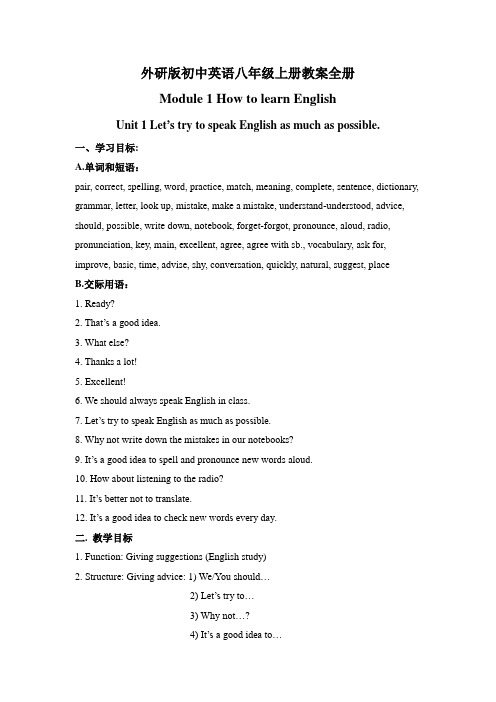
外研版初中英语八年级上册教案全册Module 1 How to learn EnglishUnit 1 Let’s try to speak English as much as possible.一、学习目标:A.单词和短语:pair, correct, spelling, word, practice, match, meaning, complete, sentence, dictionary, grammar, letter, look up, mistake, make a mistake, understand-understood, advice, should, possible, write down, notebook, forget-forgot, pronounce, aloud, radio, pronunciation, key, main, excellent, agree, agree with sb., vocabulary, ask for, improve, basic, time, advise, shy, conversation, quickly, natural, suggest, placeB.交际用语:1. Ready?2. That’s a good idea.3. What else?4. Thanks a lot!5. Excellent!6. We should always speak English in class.7. Let’s try to speak English as much as possible.8. Why not write down the mistakes in our notebooks?9. It’s a good idea to s pell and pronounce new words aloud.10. How about listening to the radio?11. It’s better not to translate.12. It’s a good idea to check new words every day.二. 教学目标1. Function: Giving suggestions (English study)2. Structure: Giving advice: 1) We/You sh ould…2) Let’s try to…3) Why not…?4) It’s a good idea to…5) How about…?6) Why don’t we/you…?7) It’s better not to…3. Skills: 1) Listening and understanding familiar topics (English study).2) Talking about problems in English study and giving advice, conductingconversations in several turns.3) Reading and finding specific information about English study.4) Drafting a letter asking for advice about English study, revising throughpair discussion..4. Around the world: English online5. Task: Writing your English study plan.三、重点及难点:Giving advice: 1) We/You should…2) Let’s try to…3) Why not…? 4) It’s a good idea to…5) How about…? 6) Why don’t we/you…? 7) It’s better not to…四、教学设计:Unit 1 Let’s try to speak English as much as possible.ⅠTeaching modelListening and speakingⅡTeaching methodPWP approachⅢTeaching aims1. To understand conversations involving advice on learning English.2. To get information about how to learn English from the conversation.3. To understand the way of giving advice.4. To practise giving advice on English learning.ⅣTeaching Objectives1. Key vocabulary: pair, correct, spelling, word, practice, match, meaning, complete,sentence, dictionary, grammar, letter, look up, mistake, make amistake, understand-understood, advice, should, possible, writedown, notebook, forget-forgot, pronounce, aloud, radio, key, main,excellent, agree, agree with sb., vocabulary2. Key structures: 1) We/You should…2) Let’s try to…3) Why not…? 4) It’s a good idea to…5) How about…? 6) Why don’t we/you…? 7) It’s better not to…ⅤTeaching aidsTape recorder, OHP , videoⅥTeaching StepsStep 1 Warming up1. Show some pictures of school things. Say how to learn English well.2. Read the words after the teacher.3. Introduce the new words.4. Learn the new words.Step 2 Read and check.1. Read the instructions in Activity 1and check(√) the ones you understand.1) Work in pairs. Ask and answer the questions.2) Correct the spelling.3) Listen and check the words you hear.4) Practise saying the words.5) Match the words with the meaning.6) Complete the sentences with the words in the box.3. Ask the students to check their answer with a partner.4. Call back the answer from the whole class and check the answer.Step 3 Listen and repeat.1. Ask the students to read the word and expressions in Activity2.dictionary grammar letter look up make a mistake meaning understand 2. Read through the questions.1) Which word did Daming not understand?2) What mistake did Lingling make?3) How does Daming usually check the spelling of a word?4) Why is it difficult for Daming to check the spelling of cinema?3. Play the recording and ask the students to listen to the recording carefully.4. Listen and answer the questions. Use the words and expressions from the box.5. Play the recording again, then they can check their answer with a partner.6. Call back the answer from the whole class and check the answer.Step 4 Listen and read.1. Show some pictures, and ask the students to talk about them.2. Ask the students to read the conversation silently.3. Play the recording and ask the students to listen and read the conversation.4. Read the conversation.5. Act it out.6. Learn “Everyday English”Ready?That’s a good idea.What else?Thanks a lot!Excellent!7. Tell the students how to learn English well.1) We should always speak English in class.2) Let’s try to speak English as much as possible.3) Why not write down the mistakes in our notebooks?4) Don’t forget to write down the correct answers next to the mistakes.5) It’s a good idea to spell and pronounce new words aloud every day.6) How about listening to the radio?7) How about reading English stories?8) W hy don’t we try to find some English pen friends?Step 5 Writing.1. Read the conversation again.2. Ask the students to write notes about learning English.Listening : listen to the radioSpeaking : ___________________________________________________ Reading : ____________________________________________________Writing: ____________________________________________________ Learning new words: ___________________________________________3. Ask the students to check with a partner.4. Check the answers:Keys:Listening : listen to the radioSpeaking : speak English as much as possibleReading : read an English storiesWriting: write to pen friends, write down our mistakes in our notebooks, write down the correct answers next to the mistakesLearning new words: spell and pronounce new words aloud every dayStep 6 Underline the correct words and expressions.1. Ask the students to read through the passage in Activity 4.Here’s my (1) advice / notebook about learning English. Speak English (2) always / as much as possible in class, and listen to English (3) in the newspaper / on the radio. I (4) agree / forget it’s a good idea to look up n ew worlds in the ( 5) notebook / dictionary. You can find the (6) correct / excellent pronunciation and learn the meaning2. Underline the correct words and expressions.3. Check with a partner.4. Call back the answers from the whole class.Keys: 1. advice 2. as much as possible 3. on the radio 4. agree 5. dictionary 6. correct 5. Read the passage together.Step 7 Listen and repeat.1. Play the recording once without stopping.2. Play the recording again and ask the whole class to repeat.1) We should always speak English in class.2) Let’s try to speak English as much as possible.3) Why not write down the mistakes in our notebooks?4) It’s a good idea to spell and pronounce new words aloud.5) How about listening to the radio?3. Ask the students to listen and mark the intonation.4. Now listen again and repeat.Step 8 Work in pairs.1. Talk about problems and give advice.Problems AdviceI can’t… How / What about …?I don’t know… Why not / don’t you …?2. Read through the example with the class.—I can’t speak English well. What should I do?—Why don’t you try to talk to our classmates in English?3. Work in pairs.Step 9 Important and difficult points1 Why not write down our mistakes in our notebooks?何不在笔记本上把我们的错误记下来?Why not …? 用来表示提出某种建议,而不是询问为什么不做某事的原因,例如:Why not take a walk in the park ?何不在公园里散散步?我们还可以用下面的表达方式来提建议:Why don’t we drive t o the country?我们何不开车去乡下?What / How about going to Europe for a holiday?去欧洲度假怎么样?Write down 或者put down 表示“记下,写下”。
2014新版PEP五年级英语上册语法重点整理

2014新版PEP五年级英语上册语法重点整理Unit one What鈥檚he like? Let鈥檚talk A Wu yi fan: Do you know Mr Wang? Olver: No,I don鈥檛.Who is he? W; He鈥檚our music teacher. O: Is he young? W: No,he isn鈥檛.He鈥檚old. O: Is he funny? W: Yes,he is. O: Great! I like funny teachers. Let鈥檚learn 鈽卭ld young funny kind strict Who鈥檚your art teacher? Mr Jones. Is he young? Yes,he is. Let鈥檚talk B Chen Jie: Hey,Ms Wang will be our new Chinese teacher. John: Really?What鈥檚she like? C: She鈥檚kind. J: Is he strict? C; Yes,sometimes. J: Do you know her? C: Yes,she鈥檚my mother! J: Haha.Cool! Let鈥檚learn polite shy helpful clever hard-working What鈥檚Wu yifan like? He鈥?hard-working. Raed and write Meet Bobin I have a robot! His name is Robin.My grandpa made him.Bobin is short but srong .He is really clever.He can speak Chinese and English.He is hard working.He is very helpful at home. He is strict,too. He makes me finish my homework. 璁茶ВBe鍔ㄨ瘝鐨勭敤娉?Think and match I_____ helpful! You____ clever. He ____funny. She ____ kind. It ____small. They______old. We_____strong.Unit 2 My week Let鈥檚talk A John: Grandpa!look at my picture. Grangpa:Great!what do you have on Thursday? John: I have maths,English and music. Grandpa: Oh,I love music! Who鈥檚your music teacher? John: Mr Young. Grandpa: Is he strict? John: No.He鈥檚funny.What do you do on Thursday,Grandpa? Grandpa: Oh,Ihave a cooking class with your grandma! John: Haha! Let鈥檚learn tabletime Monday Tuesday Wednesday Thursday Friday Chinese maths English PE art What do you have on Mondays? I have Chinese,English,maths and music.舰寮?Let鈥檚talk B 锛圛t鈥檚Saturday afternoon锛?Zhang Peng: Hi,Sarah.What 鈥檚that? Sarah: It鈥檚 a storybook. Zhang: Do you often read books in this park? Sarah: No,I don鈥檛. Do you often play football here? Zhang: Yes,I do.I like this parkvery much. Sarah: Me too. Ask and answer: A: Do you often play ping-pang on the weekend? B: yes, I do. A: Do you often listen to music? B: No,I don鈥檛. Let鈥檚learn Wash my clothes watch TV do homework read books play football A: Do you often wash your clothes on the weekend? B: Yes, I do. Group work e.g(渚嬪瓙): What do you often do on the weekend? I often do my homework,read books, watch TV and draw pictures on the weekend.Unit3 What would you like? Let鈥檚talk A Father: I鈥檓hungry. Mother: What would you like to eat? Father: A sandwich,please! Mother: Ok! Sarah: What would you like to drink? Father: I鈥檇like some water.I鈥檓thirsty! Sarah: Here you are! Father: Thanks! Let鈥檚learn ice cream tea hamburger sandwich salad What would you like? I鈥檇like a sandwich,please! Role 锟紺play () What would you like to eat? I鈥檇like 鈥︹€? What would you like to drink? I鈥檇like 鈥︹€︹€? Let鈥檚talk B 锛堝紶楣忓拰Sarah Sarah 锛歐hat鈥檚your favourite food? Zhang Peng: Noodles.Ilove beef noodles.They 鈥榬e delicious.What鈥檚your favourite food? Sarah: Fish! Zhang Peng:Well,let鈥檚see.We have beef noodles and fish sandwiches today. Sarah: Great! Let鈥檚learn fresh healthy delicious hot sweet A: What鈥檚your favourite food? B: Ice cream. It 鈥檚sweet Read and write Robin will cook today Dear Robin, My favourite food is ice cream. It is sweet.Idon鈥檛like beef but chicken is ok.Onions are my favourite vegetable.I like Salad very much. Thank you! Yifan What would you like to eat? Write to Robin,please. (璇风粰Robin鍐欏皝淇? Dear Robin, My favourite food is_______.It is _____. I don鈥檛like _______but I like ________. Thank you !_________ 璁茶В鍚嶈瘝澶嶆暟Unit4 What can you do ? Let鈥檚talk A Miss White:We鈥檒l have an English party next Tuesday! What can you do for the party,children? Zhang Peng: Ican sing English songs. Miss White: Wonderful! How about you,John? John: I can do some Kung fu! Miss White: Thank you,John. Let鈥檚learn dance sing English songs play the pipado kung fu draw cartoons A: What can you do ? B: I can draw cartoons. Let鈥檚talk B Mr Ma: Good afternoon,children.Today we鈥檒l learn some kung fu. Children: Cool! Mr Ma; Can you do any kung fu,John? John: Yes ,I can. Mr Ma; Wonderful! Mr Ma; Can you do any kung fu ,Oliver? Oliver: No,Ican鈥檛. Mr Ma;No problem. Ican help you. Let鈥檚learn Swim speak English cook play basketball play ping-pong A: Can you swim? B: Yes,I can.I can do some kung fu,too锛?Write and say I can speak English and Chinese.I can sing English songs.I can dance.Ican swim.I can cook.Ican play ping-pong. I can鈥檛do any kungfu.Ican鈥檛play the pipa. Unit5 There is a big bed Let鈥檚talk A Sarah: Your room is relly nice! Zhang Peng: Thanks! Unit 5 There is a big bed Mike: Thereis a big bed. Zhang Peng: Yes,I like my bed. Mike: There is a nice photo,too. Sarah: Wow! You look cool! Zhang Peng: Thank you. Hey,my computer is here on the desk. Let鈥檚play! 瀛︿範There is 鍙ュ瀷銆傜敾涓€骞?There is a desk in the picture. There is a plate on the desk. Let 鈥檚learn clock photo plant water bottle plant bike This is my room, there is aclock on the wall鈥︹€?Let鈥檚play There is aclock in my room . There is a clock and a plant in my room. There is a clock ,a plant and a photo in my room. Let鈥檚talk B Zhang Peng: This is the living room. Mike: Wow!There are so many pictures here. Zhang: Yes .My father can draw very well. Sarah: There are so many plants here,too. Zhang: They鈥檙e my grangmother鈥檚plants.My grandparents have a garden in front of their house.There are lots of flowers in it. Sarah:Cool! 瀛︿範there are 鍙ュ瀷銆俆here are 鍚庡姞鍚嶈瘝澶嶆暟銆?e.g There are two dogs in the picture. There are some fish in the fish bowl. Let鈥檚learn in frongt of beside between behind obove A: Where is the ball? B: It鈥檚in front of the dog. Read and write Dear Robin, I am Yifan鈥檚art teacher.I just moved into an ole house. The rooms are dirty.There are pencils ahd crayons on the floor.There are pictures and photos everywhere.Oh ,no!I see a mouse behind my computer! Please help me.I live near the nature park,Please hurry! Mr Jones What鈥檚in your room? Write threesentencesUnit6 In a nature park Let鈥檚talk A Miss White: Children,let鈥檃go to the forest! Chilren : Yeah! Zhang Peng: Is there a river in the forest,Miss White? Miss White: No,there isn鈥檛. Zhang Peng: Is there a lake,Miss White? Miss White:Yes,there is and there are some small boats. Zhang Peng: Cool! Let鈥檚go boating. Let鈥檚learn forest hill river mountain lake A: Is there a river in therpark? B: Yes ,there is. Practice:Talk about the park with your partner. e.g. Is there a lake in the park?Yes ,there is. Is there a forest? 鈥︹€︹€︹€?. Let鈥檚talk B Zhang Peng: The nature park is so quiet! Miss White: Yes,Zhang Peng.There aren鈥檛many people. Zhang Peng: Are there any tall buildings in the nature park? Miss White: No,there aren鈥檛. Zhang Peng: Zre there any animals? Miss White:Yes, there are ducks and rabbits. Let鈥檚learn Village house tree bridge building A: Are there any lakes on the mountain? B: Yes,there is one. Read and write Robin draws Robin is at Mr Jones 鈥?house.There is a nature park near the house.In the park there is a high mountain.In front of the mountain thereis a small village.There is a lake near the village.There are many ducks on the lake.。
新目标七年级上册每单元英语作文范文
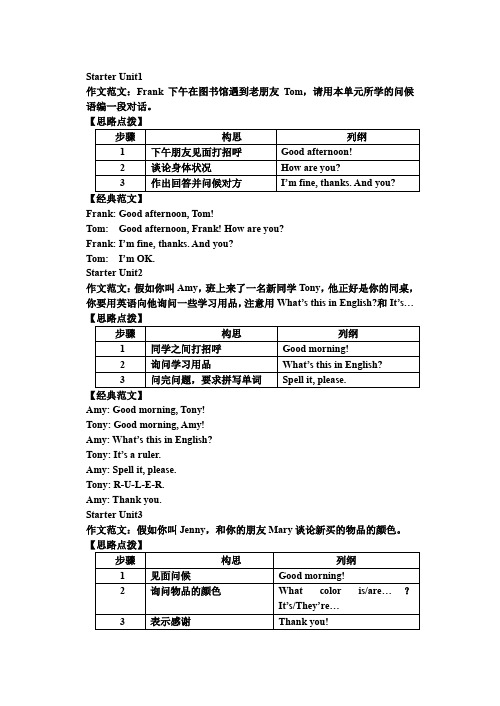
Starter Unit1作文范文:Frank下午在图书馆遇到老朋友Tom,请用本单元所学的问候语编一段对话。
【思路点拨】Frank: Good afternoon, Tom!Tom: Good afternoon, Frank! How are you?Frank: I’m fine, thanks. And you?Tom: I’m OK.Starter Unit2作文范文:假如你叫Amy,班上来了一名新同学Tony,他正好是你的同桌,你要用英语向他询问一些学习用品,注意用What’s this in English?和It’s…【思路点拨】Amy: Good morning, Tony!Tony: Good morning, Amy!Amy: What’s this in English?Tony: It’s a ruler.Amy: Spell it, please.Tony: R-U-L-E-R.Amy: Thank you.Starter Unit3作文范文:假如你叫Jenny,和你的朋友Mary谈论新买的物品的颜色。
【思路点拨】【经典范文】Jenny: Good morning, Mary!Mary: Good morning, Jenny!Jenny: What color is your pen?Mary: It’s green.Jenny: How about your pencils?Mary: They’re blue.Jenny: Oh, they’re beautiful!Mary: Thank you!Unit1作文范文:根据自己的实际情况,写一篇介绍自我的范文,词数30词左右,语句完整。
Hello, everyone! My name is . I’m 13. is my first name, and is my last name. I am a happy .I’m a student. I’Unit2作文范文:假如你是Bob,请你给你的笔友Mike 写一封信,介绍一下你自己的家庭。
小学英语《PartA Let’s talk and Let’s play》优质课教学设计、教案

一、教学目标人教版小学英语四年级下册《Unit 4 At the farm》PartA Let’s talk and Let’s play 教学设计1、知识与能力:掌握新单词carrots、tomatoes;掌握并熟练运用句型What are these?Are these...?Yes,they are./No,they aren't;能够理解事物的复数概念。
2、过程与方法:合作与竞争,创新思维的开发。
3、情感态度价值观:培养学生善于观察,勤于提问的习惯,激发学生的求知欲;增进学生之间的交流,形成团结互助的课堂气氛,培养学生的小组合作能力;通过体验式教学,激发学生亲近自然、热爱自然的情感。
二、教学重、难点1、教学重点:掌握新单词carrots、tomatoes;掌握句型What are these?Are these...?Yes,they are./No,they aren't.2、教学难点:能够理解事物的复数概念;掌握these 的发音。
三、教学准备1、教师:本课的授课课件、图片、音乐、视频等多媒体素材;水果、蔬菜实物。
2、学生:对本课内容进行课前预习。
四、教学过程Step 1 Warm up1、Greeting:师生进行简单问候。
2、Sing a song:Apple treeStudents sing and do together with the teacher.Teacher:Boys and girls,do you like apples?Look,I have a big apple tree.There are so many sweet apples.Let's pick the apples.Step 2 Presentation1、Pick applesEncourage students to pick apples.点ft苹果出现一幅图片,教师用What are these?来提问,学生回答,通过问答学生复习以前所学的蔬菜水果,并学习新的词汇tomatoes、carrots,为后面的学习做准备。
小学英语三年级上册PEP1 Unit1 A-B Let's talk Let's play教学设计和反思
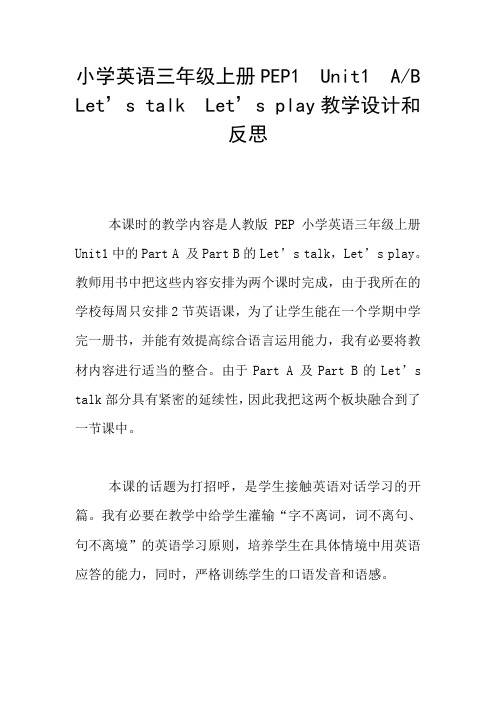
小学英语三年级上册PEP1 Unit1 A/B Let’s talk Let’s play教学设计和反思本课时的教学内容是人教版PEP小学英语三年级上册Unit1中的Part A 及Part B的Let’s talk,Let’s play。
教师用书中把这些内容安排为两个课时完成,由于我所在的学校每周只安排2节英语课,为了让学生能在一个学期中学完一册书,并能有效提高综合语言运用能力,我有必要将教材内容进行适当的整合。
由于Part A 及Part B的Let’s talk部分具有紧密的延续性,因此我把这两个板块融合到了一节课中。
本课的话题为打招呼,是学生接触英语对话学习的开篇。
我有必要在教学中给学生灌输“字不离词,词不离句、句不离境”的英语学习原则,培养学生在具体情境中用英语应答的能力,同时,严格训练学生的口语发音和语感。
学情分析教学对象是三年级学生,身处边远农村,学生从未接触过英语,在语言运用和表达上可能会出现一定的困难。
但根据我对这个年级的了解(两年前的这个时候我任他们的语文教师及班主任),少数孩子比较内向,性格比较孤僻;但这些孩子们的思维活跃,积极热情,喜欢挑战,喜欢表现自我,且对英语课充满好奇,竞争意识和集体荣誉感都很强。
我根据学生的不同特点,想法设法组织一些积极有益的游戏活动激活学生原有的知识经验及语言能力,尽量让每位学生都能够乐于表达,融入我的课堂中来。
由于三年级的学生自我控制能力还较弱,我有必要多次强调活动的规则。
学生在此之前,已经学了“Welcome to English”蝴蝶页的内容及《ABC》、《Hello》等儿歌,并对英语学习产生初步的兴趣。
因此,在本课中,我比较注意运用学生已学的语言储备,利用知识的正迁移,组织好教学。
教学目标结合教材特点与学生现有知识储备,我制定了以下教学目标:知识与技能:1、学生能听、说Hello、Hi、I’m XXX、My name is XXX、What’s your name、Goodbye、Bye、See you、Welcome,并能做出正确的应答。
let's play翻译成中文
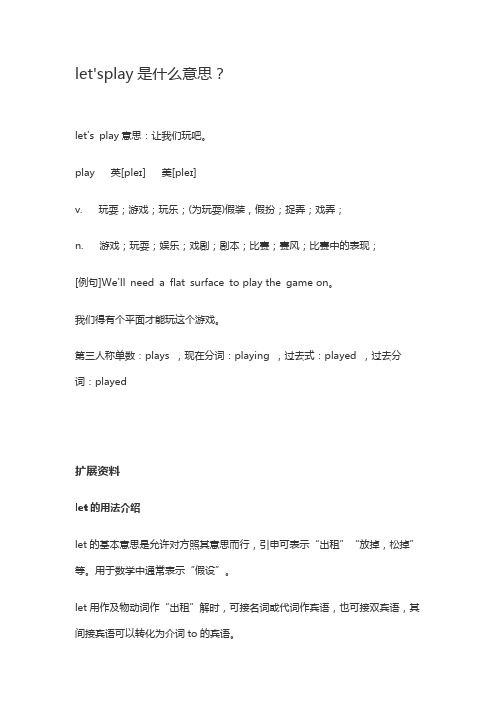
let'splay是什么意思?
let's play意思:让我们玩吧。
play 英[pleɪ] 美[pleɪ]
v. 玩耍;游戏;玩乐;(为玩耍)假装,假扮;捉弄;戏弄;
n. 游戏;玩耍;娱乐;戏剧;剧本;比赛;赛风;比赛中的表现;
[例句]We'll need a flat surface to play the game on。
我们得有个平面才能玩这个游戏。
第三人称单数:plays ,现在分词:playing ,过去式:played ,过去分词:played
扩展资料
let的用法介绍
let的基本意思是允许对方照其意思而行,引申可表示“出租”“放掉,松掉”等。
用于数学中通常表示“假设”。
let用作及物动词作“出租”解时,可接名词或代词作宾语,也可接双宾语,其间接宾语可以转化为介词to的宾语。
let通常接以形容词或不带to的动词不定式充当补足语的复合宾语;接动词不定式作宾语补足语时,如用于被动结构,to须保留。
例句如下:
1、I won't let him get away with that excuse.
我不会让他用那种借口蒙混过去。
2、I don't agree with all you say, but I'll let it go at that。
我并不完全同意你说的话,但我不再多说了。
冀教版六年级英语下册Let’s play重点知识汇总
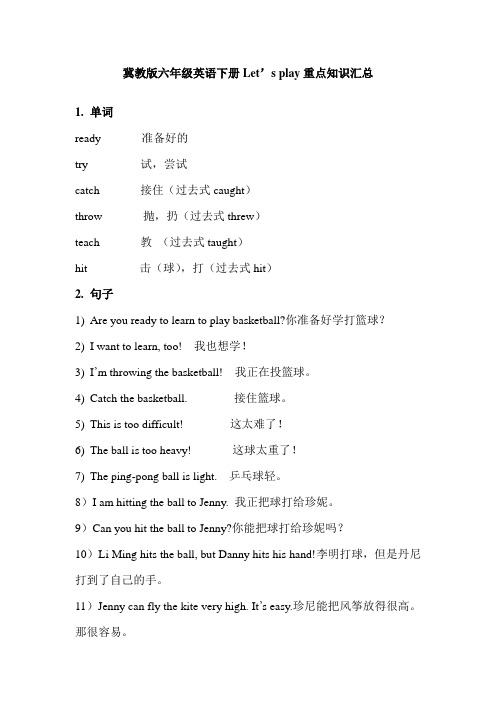
冀教版六年级英语下册Let’s play重点知识汇总
1.单词
ready 准备好的
try 试,尝试
catch 接住(过去式caught)
throw 抛,扔(过去式threw)
teach 教(过去式taught)
hit 击(球),打(过去式hit)
2.句子
1)Are you ready to learn to play basketball?你准备好学打篮球?
2)I want to learn, too! 我也想学!
3)I’m throwing the basketball! 我正在投篮球。
4)Catch the basketball. 接住篮球。
5)This is too difficult! 这太难了!
6)The ball is too heavy! 这球太重了!
7)The ping-pong ball is light. 乒乓球轻。
8)I am hitting the ball to Jenny. 我正把球打给珍妮。
9)Can you hit the ball to Jenny?你能把球打给珍妮吗?
10)Li Ming hits the ball, but Danny hits his hand!李明打球,但是丹尼打到了自己的手。
11)Jenny can fly the kite very high. It’s easy.珍尼能把风筝放得很高。
那很容易。
12)Let me try! 让我试试!。
- 1、下载文档前请自行甄别文档内容的完整性,平台不提供额外的编辑、内容补充、找答案等附加服务。
- 2、"仅部分预览"的文档,不可在线预览部分如存在完整性等问题,可反馈申请退款(可完整预览的文档不适用该条件!)。
- 3、如文档侵犯您的权益,请联系客服反馈,我们会尽快为您处理(人工客服工作时间:9:00-18:30)。
B: My sister and I _________sore have throats. Should we go to school? __________
A: No, you_________. shouldn’t
3.A: _______ Does Mike ______ have a fever? has B: No, he doesn’t ______. He ______a stomachache. should drink some hot tea. A: He _______
4b Circle the best advice for these health problems. Then add your advice.
1.Jenny cut herself.
She should (get an X-ray / put some medicine
on the cut). She should put some medicine My advice:____________________________ on the cut ____________________________.
2.Kate has a toothache. She should (see a dentist / get some sleep). She should see a dentist My advice:__________________________.
3.Mary and Sue have colds.
You should go to see a doctor. 你应该去看医生。(提出建议)
should 应该做某事
should 情态动词, 没有人称和数的变化 结构: should + 动词原形
否定: should not (shouldn’t) + 动词原形
should除了作 shall的过去式外, 还表示”应该,应当”, 后加动词原形,可
1. what’s the matter?
2. What do I do?
See the doctor;
Take some medicine;
Drink hot water;
Lie down and rest.
have a bad cold have a high fever be in a fever
Guess
I have a toothache.
What’s the matter?
What’s the matter? My leg hurts.
问 病 症 的 几 种 句 子
1. What’s the matter ?
I have a fever. 2. What’s the matter with you? I have a fever. 3. What’s the matter, Amy ? I have a cold. (有逗号的,那个人就是自己) 4. What’s the matter with Amy ? She has a cold. ( with 谁就问谁) 5. What’s the matter with her / him /it? She / He/ It has a cold. ( with 宾格,回答变主格)
She has a fever.
headache have a toothache sore
the matter
hurts
Let’s play.
I have a fever. What’s the matter?
驾考宝典 / 驾考宝典2016科目一
Answer the questions:
第三人称单数知识扩充: 一、人称代词he, she, it是第三人称单数。 如: He likes watching TV. 他喜欢看电视。 It looks like a cat. 它看起来像只猫。 二、单个人名、地名或称呼作主语;是第三人称单数。 如: ①Han Mei looks like her mother. 韩梅看起来像她的母亲。 ②Beijing is in China. 北京在中国。 ③Uncle Wang often makes cakes. 王叔叔经常做蛋糕。 三、单数可数名词或“this / that / the+单数可数名词”作主语时,是 第三人称单数。如: ①A horse is a useful animal. 马是有用的动物。 ②This book is yours. 这本书是你的。 ③That car is red. 那辆小汽 车是红色的。 ④The cat is Lucy‘s. 这只猫是露茜的。
ache 、sore和hurt 的区别:
ache 是一个名词后缀,如:toothache , headache ,stomachache; sore 是一个形容词,用来修饰名词,指的是 身体某一部位的酸痛。如:sore back, sore throat hurt是一个动词,指“刺痛,使受伤痛”。 如:He hurts his leg.他伤了腿。还可以说“His leg hurts.”他腿疼。
B: She should take her temperature. A: Should I put some medicine on it? B: Yes, you should./ No, you shouldn’t.
to test your sense of observation to test your ability of short-term memory to test your ability to highlight the language points
用于各种人称。它比 must 委婉, 用来表示
向对方提出建议和忠告, 或者表示某种 义务或责任。其否定式为 shouldn’t。 变为一般疑问句时should提到主语的 前面。
例如: We should study hard. 我们应该努力学习。 We shouldn’t listen to music in class.
四、不定代词someone, somebody, nobody, everything, something 等及指示代词this, that作主语时,是第三人称单数。如: ①Everyone is here. 大家到齐了。 ②There is something wrong with the watch. 这块手表有毛病。 ③This is a pen. 这是一支钢笔。
我们不应当课上听音乐。
Explanation
1. What’s the matter with you?你怎么了?
What’s the matter with you?这个句子还有
一个同义句:What’s wrong with you?
但回答的方法仍旧相同。
2. 其他的病情都是have a …/has a… 如: I have a cold. She has a cold. I have a toothache. She has a toothache. I have a headache. She has a headache. 3. Hurt 是受伤的意思,表示什么受伤。 如:My leg hurts. His legs hurt. Her arm hurts.
4a. Fill in the blanks and practice the conversations.
1.A:I hurt________ myself when I played basketball should I do? yesterday. What _______
B: You_______ should see a doctor and get an X-ray.
严重的感冒
发高烧
在发烧
Grammar Focus
A: What’s the matter? B: I have a stomachache. A: You shouldn't eat so much next time.
A: What’s the matter with Ben?
B: He hurt himself. He has a sore back. A: He should lie down and rest. A: Do you have a fever?
They shouldn’t (sleep / exercise).
They shouldn’t exercise My advice:___________________________.
4.Bob has a sore back.
He should (lie down and rest / take his temperature). He should lie down and rest My advice:__________________________.
B: Yes, I do./ No, I don’t./ I don’t know.
A: Does he have a toothache? B: Yes, he does. A: He should see a dentist and get an X-ray.
A: what should she do?
Unit 1
What’s the matter ?
A: What’s the matter?
B: I have a sore throat.
What’s the matter?
She has a toothache.
What’s the matter?
She has a headache.
